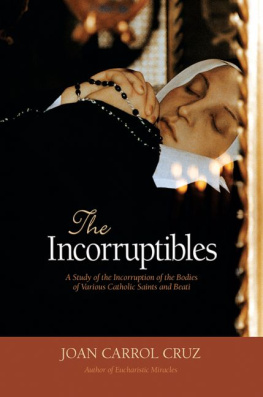Joan Carroll Cruz - Lay Saints: The Noble and the Humble
Here you can read online Joan Carroll Cruz - Lay Saints: The Noble and the Humble full text of the book (entire story) in english for free. Download pdf and epub, get meaning, cover and reviews about this ebook. year: 2016, publisher: TAN Books, genre: Non-fiction. Description of the work, (preface) as well as reviews are available. Best literature library LitArk.com created for fans of good reading and offers a wide selection of genres:
Romance novel
Science fiction
Adventure
Detective
Science
History
Home and family
Prose
Art
Politics
Computer
Non-fiction
Religion
Business
Children
Humor
Choose a favorite category and find really read worthwhile books. Enjoy immersion in the world of imagination, feel the emotions of the characters or learn something new for yourself, make an fascinating discovery.

- Book:Lay Saints: The Noble and the Humble
- Author:
- Publisher:TAN Books
- Genre:
- Year:2016
- Rating:5 / 5
- Favourites:Add to favourites
- Your mark:
- 100
- 1
- 2
- 3
- 4
- 5
Lay Saints: The Noble and the Humble: summary, description and annotation
We offer to read an annotation, description, summary or preface (depends on what the author of the book "Lay Saints: The Noble and the Humble" wrote himself). If you haven't found the necessary information about the book — write in the comments, we will try to find it.
Lay Saints: The Noble and the Humble — read online for free the complete book (whole text) full work
Below is the text of the book, divided by pages. System saving the place of the last page read, allows you to conveniently read the book "Lay Saints: The Noble and the Humble" online for free, without having to search again every time where you left off. Put a bookmark, and you can go to the page where you finished reading at any time.
Font size:
Interval:
Bookmark:
the Humble
the Humble
TAN Books
Charlotte, North Carolina
Copyright 2016 TAN Books.
Lay Saints: The Noble and the Humble is a selection of saints biographies originally appearing in Secular Saints 1989 by Joan Carroll Cruz. Revisions to the original biographies include updating of diction, punctuation, and spelling, along with the correction of occasional errors in typography, spelling, grammar, syntax, and factual information.
All rights reserved. With the exception of short excerpts used in articles and critical review, no part of this work may be reproduced, transmitted, or stored in any form whatsoever, without the prior written permission of the publisher.
Cover design by David Ferris.
www.davidferrisdesign.com
Cover image: St. Louis Healing the Sick (oil on canvas), Le Sueur, Eustache (1617-55) / Musee des Beaux-Arts, Tours, France / Bridgeman Images
ISBN: 978-0-89555-697-4
Printed in the United States of America.
TAN Books
Charlotte, North Carolina
www.TANBooks.com
2016
This book is
dedicated with love
to
The Holy Family
A NATIONAL Catholic magazine polled a thousand of its readers to learn what they believe about the saints. The magazine reported that while news reports on the nations Catholics have highlighted disagreements with traditional Church teachings, sixty-seven percent of the surveys respondents said they prayed to the saints as much, or more, than they did years ago. Sixty-eight percent of the respondents said they tried to imitate the lives of the saints.
Mentioned as the four favorite saints were the Blessed Mother, St. Joseph, St. Francis of Assisi and St. Thrse of Lisieux (the Little Flower). With the exception of the Blessed Mother and St. Joseph, who are in a unique category, we are left with a Franciscan brother and a Discalced Carmelite cloistered nun. While we can admire the virtues of St. Francis and St. Thrse, the lifestyles of these two saints, and other saints of religious orders, are far removed, to say the least, from those of secular people.
Although the exact number of canonized saints is unknown, we know, of course, that the greater majority have been members of religious orders. We love them, we admire them, we wish to imitate them, but how can a mother with small children, a wife with a difficult husband, a young bride with in-law problemshow can they really relate to the nun who lived in the quiet of a cloister, the nun who lived in a community where everyone shared the work of the house? How can they relate to the saints of religious orders whose lives were arranged in an orderly manner and who had designated times for quiet prayer and who had little or no financial problems? One might wonder if these saints of the cloister would have merited their titles if they had remained in the world to face the conflicts and dangers confronted by ordinary lay people.
It is profitable, of course, for laymen to love these saints, to pray to them and to imitate their virtues as much as they are able. But it seems that laymen would draw more encouragement to advance in prayer and virtue and would derive more consolation in their trials by examining the troubles and temptations of those saints who lived and died as secular members of the Church.
St. Teresa of Avila suggests that we need to cultivate and think upon, and seek the companionship of those saints who, though living on earth like ourselves, have accomplished such great deeds for God. Here, then, are the lives of secular saints who have, so to speak, lived on earth like ourselves. Represented here are single men and women, mothers and fathers, soldiers and servants, doctors and lawyers, the humble and the nobleall who have met the difficulties and challenges of the secular life and triumphed over them. Their virtues are to be admired, but most of all imitated. May we benefit from their example and from their prayers.
Joan Carroll Cruz
A WORD ABOUT THE
BLESSED VIRGIN MARY
A BOOK about secular saints would be incomplete without mentioning the pre-eminent model for secular people, the Blessed Mother. But what could be said here that has not been mentioned about her already in numerous biographies and devotional works? We have only to delve into these to find a solicitous and understanding mother, a kindly and generous friend, a consoling companion, and a ready and willing intercessor with God.
Although it is known that Mary was free from sin, full of grace, blessed among women and the fairest honor of our race, yet, as we know, she was not exempt from countless trials and hardships. She, who was the model of saints throughout the ages, should be the particular ideal of secular people, since Mary was an exemplary member of our secular ranks. She was, of course, a young bride, a young mother, a housekeeper, a widow.
May this Immaculate Mother pray for us, that in our imitation of the saints, we can advance in virtue and eventually join her and her sainted children in our heavenly homeland.
the Humble
And he that invited thee and him, come and say to thee, Give this man place: and then thou begin with shame to take the lowest place. But when thou art invited, go, sit down in the lowest place; that when he who invited thee, cometh, he may say to thee: Friend, go up higher. Then shalt thou have glory before them that sit at table with thee. Because every one that exalteth himself, shall be humbled; and he that humbleth himself, shall be exalted.
Luke 14:911
AND NOBLES
T HE history of St. Adelaide (Adelheid) is dominated by the tenth-century power struggle and intrigue of certain parties for control of the kingdom of Italy. Adelaide was born into this struggle, being the daughter of Rudolph II, king of Burgundy, who was at war with Hugh of Provence for the Italian crown. In 933 the rivals reached a peace agreement by which it was stipulated that Adelaide, the daughter of one rival, should marry Lothaire, the son of the other rival. Adelaide was then only two years old. Fourteen years later her brother, Conrad of Burgundy, arranged the marriage and thereby fulfilled the contract. This marriage produced one child, a daughter, who was named Emma.
As a result of this marriage, Adelaides husband, Lothaire, was considered the king of Italy. However, Berengarius, the marquis of Ivrea, came upon the scene and claimed the kingdom of Italy for himself. When Lothaire suddenly died in 950, it was suspected that he had been poisoned by Berengarius, who succeeded him. Berengarius then attempted to force the widow Adelaide to marry his son, Adalbert. When she refused, Berengarius treated her with brutality and kept her in almost solitary confinement in the Castle of Garda. From there she was rescued by a priest named Martin, who is said to have dug a subterranean passage by which she escaped. Adelaide remained concealed in the woods until her friend Alberto Uzzo, the duke of Canossa, heard of the rescue and conveyed her to his castle.
While this was taking place, the Italian nobles, having grown weary of Berengarius, invited Otto the Great of Germany to invade and seize the country for himself. Otto met little resistance and promptly defeated Berengarius. To consolidate his authority in Italy, Otto married Adelaide at Pavia in the year 951. Adelaide had been a widow for one year and was twenty years younger than Otto. Of Adelaides second marriage, five children were born: Otto II, Henry, Bruno and two daughters, who eventually became nuns.
Font size:
Interval:
Bookmark:
Similar books «Lay Saints: The Noble and the Humble»
Look at similar books to Lay Saints: The Noble and the Humble. We have selected literature similar in name and meaning in the hope of providing readers with more options to find new, interesting, not yet read works.
Discussion, reviews of the book Lay Saints: The Noble and the Humble and just readers' own opinions. Leave your comments, write what you think about the work, its meaning or the main characters. Specify what exactly you liked and what you didn't like, and why you think so.




